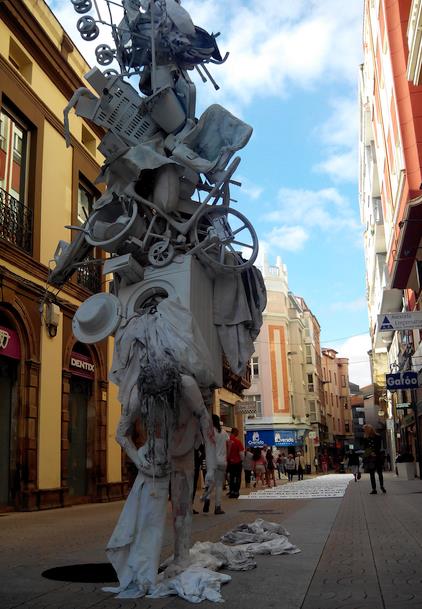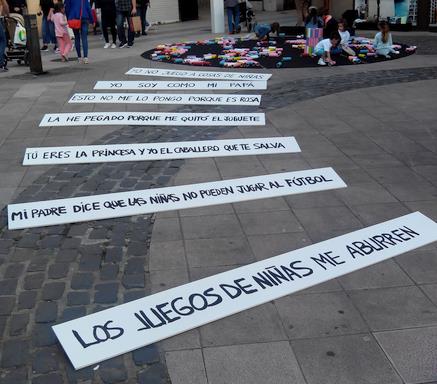La Asociación Cultural Octubre vuelve a despertar conciencias con «Deconstrucción»

La Asociación Cultural Octubre vuelve a despertar conciencias con «Deconstrucción»
-En esta ocasión las instalaciones artísticas se centran en el machismo
-El objetivo de este trabajo es recordar, visibilizar, analizar, identificar, desaprender para aprender de nuevo, señalar, denunciar y eliminar las actitudes machistas

No es la primera vez que la Asociación Cultural OCTUBRE expresa, a través del arte, su malestar y desacuerdo con la realidad que nos está tocando vivir, mostrando una actitud crítica hacia una sociedad ‘cada vez más caracterizada por la desigualdad, la explotación y la injusticia’, señalan los organizadores.
Durante este sábado 16 de junio han llevado a cabo varios montajes artísticos en las calles de Torrelavega, que han vuelto a sorprender a cientos de visitantes. En ocasiones, los niños han mostrado su extañeza por los mensajes de WhatsApp mostrados en teléfonos gigantes, mientras que alguna madre les ha explicado que son mensajes «malos» contra las mujeres, y que no se debe hacer.

En el 2016, la Asociación Cultural Octubre realizó una instalación artística sobre los refugiados, titulada “A la deriva”. Y el año pasado “Despierta”, acerca de la pasividad de la sociedad ante tanto atropello y vulneración de derechos en los tiempos de crisis.
En esta nueva acción artística se habla de género, de desigualdad, de discriminación. «Queremos hablar de machismo. Un machismo con el que convivimos habitualmente, muy normalizado entre nosotros y nosotras, y que puede evolucionar hacia la violencia más cruel», explica la asociación.

‘La cultura establece un conjunto de ideas, creencias y valoraciones sobre el significado que tiene ser hombre y ser mujer. Se delimitan los comportamientos, las características, los pensamientos y emociones, e incluso los derechos que son adecuados para cada uno de ellos, en base a estereotipos o ideas consensuadas, y de una manera muy desigual entre ambos’, detalla el colectivo.
«Toda esta cultura de división de sexos y de dominación y subordinación de un sexo sobre otro se conoce como patriarcado. Fue la primera estructura de dominación y subordinación de la historia, no sólo ideológica y psicológica, sino también social y económica. Ha sido capaz de sobrevivir y avanzar a través de siglos y periodos históricos, se ha adaptado a distintas culturas y sistemas sociales, manteniéndose y perpetuándose en el tiempo. Y aún hoy sigue siendo un sistema de dominación, un sistema machista, un sistema de desigualdad que cuesta percibir como tal».
La asociación opina que el machismo no se percibe porque vivimos en una sociedad que, desde que nacemos, ‘constantemente nos bombardean con mensajes y estereotipos sexistas promovidos por el modelo de masculinidad tradicional’.
«Estamos hablando de una violencia simbólica, más sutil, y una violencia cotidiana, que está presente en cada día de nuestra vida en todo lo que vemos y todo lo que hacemos. Son formas de violencia menos visibles que la violencia directa, pero no por ello, menos dañinas. Este tipo de violencia simbólica y cotidiana es el pilar que sostiene la violencia más cruel, la que explota, viola y mata a las mujeres», opinan en un comunicado.
«Lo que nos hemos propuesto con este trabajo es recordar, visibilizar, analizar, identificar, desaprender para aprender de nuevo, señalar, denunciar y eliminar las actitudes machistas. Nos hemos propuesto deconstruir», apunta el colectivo.
«¿Quién dijo que el machismo había desaparecido? El machismo ha cambiado. No se trata de una característica de personalidad sino de una forma de relación interpersonal, y no solo como una opresión o esclavitud realizada hacia las mujeres, sino como una serie de creencias y actitudes implícitas que se manifiestan en la vida cotidiana. El machismo es más silencioso, está asimilado, es más invisible y más moderno. Machismo que dejamos pasar por costumbre pero que va minando poco a poco a sus víctimas. Machismo que se hace bola en las tertulias de la tele, en los grupos de whatsapp de nuestros hijos e hijas o en los clasificados de un periódico».

«Por ello, consideramos el feminismo no sólo como movimiento, sino como cultura necesaria que desarma, desmonta, deconstruye la cultura machista del patriarcado, creando nuevos modelos más igualitarios entre todas las personas. Afortunadamente, hoy, muchas mujeres y hombres vienen pisando muy fuerte, luchando por la igualdad de derechos y oportunidades entre todas las personas, y en todos los ámbitos de nuestras vidas»
En los diferentes montajes se han visto estereotipos como «los juegos de niñas me aburren»; «el rosa es para niñas»; «me paso el día trabajando y tú gastando», entre otras frases.
- El colegio La Paz de Torrelavega recoge alimentos para el Banco de Alimentos de Cantabria - 22 diciembre, 2025
- Polanco inicia el pago de un centenar de ayudas y becas al deporte - 22 diciembre, 2025
- El Festival de Títeres se traslada al Concha Espina ante amenaza de lluvia - 18 diciembre, 2025
1 Comment
[…] . These advocates all hold a deep and significant value in common: the affirmation that ‘family’ is more than a functionality; not merely a function of biology, nor a function of expedient proximity. . Alas, we see the functionalised family everywhere – overfunctioning, and dysfunctional forms are common expressions of family, and some of our best ways of helping families employs a family-systems theory. I am in fact a fan of Bowen family systems theory as a diagnostic process and a way of opening ourselves to fresh perspectives on our behaviours and alliances. Despite the modernist, structuralist overtones of the title, Bowen’s theory in fact offers a subtle and complex way of paying attention to the needs and values and play and relationships between humans, deeply recognised as humans in community – not essentially hierarchy – with one another. Bowen offers a way of deconstructing the automations of family and inviting fresh ways of seeing one another. . . * . . In this last season, my little nuclear family has gone through a radical reordering in its most basic functions. We are not one of those families who are all on Whatsapp and have a shared gooogle calendar: One of us barely uses phone messaging, and we never managed a roster, even for the dishes. We are all kinds of organisational chaos. I’m not actually recommending the chaos – there are reasons our family culture evolved this way. And now we are an even stranger mix of togethers and aparts. . Neither am I going to claim that “despite our unstructured chaos, we all know how deeply we love each other and have great relationships.” . That would be way out of line to speak on behalf of others – family though we be. Besides, no one buys that kind of sit-com ‘Happy families’ cheesiness anyhow. In the past year we have all had difficult conversations with one another. If we love, we hurt. It’s real life. . Lacking a smooth-running, conventional, middle-class, functional family, I cannot hold the modular plasticised family aspirations. It is beyond me, as it is beyond many in the world, simply circumstantially. Those who hold this as a gold standard, hold to an idol. A sculpture made with human hands, like the Torrelavega exhibition above. Those who cling to idols have their hands full. . Rather, I hold myself joyfully, if still gently, to these questions: . Do my family members know that I see their whole humanity and cherish it? . Do they feel honoured, not only in values they know we hold in common, but in in their differences? . What do they find plenty of in our family community? – love? – freedom to pursue their calling and endeavours? – unconditional acceptance? – faith? – invitation to ask for what they need? – a sense that they bring something precious and valued that is recognised by others? – encouragement to stretch and risk and a safe place to land when they fall? -Weetbix? > I hold myself to this through my own small version of art, connecting my gendered body and identity to family and meaning. In May 2017 our family was moving into a season of deep changes in a variety of directions; physically, geographically, emotionally. . I got three tattoos of ravens, all in flight – one on my forearm, one on my chest above my heart, and one on my shoulder. I inscribed the [other] three members of the family on my body in art, I pictured them in motion, but nevertheless constantly with me. . They are also Elijah’s Ravens from 1 Kings 17, bearers of God’s sustaining provision and care in years of weary drought. I confess I’ve mother-muddled my way through the years, with one northern star to guide me: You live with children who are whole human beings. Love and respect and regard and remember the whole human. They are not yours. They are not a ‘part’ of your family operation. They are whole. You are a whole too. Be whole with one another. This has been challenging. Lots of systems – like schools and churches and extended family – function with forces that fragment this wholeness. . * . Art – tattooed on a body or installed in a public square offers moments of reflection and provokes questions that open our imagination . What would a gender-inclusive version of this sculpture look like? What would a masculinist version of this sculpture look like? What would versions of this sculpture envisaging motherhood from across the majority world look like? What would a historical version of this sculpture holding the world of our great grandmothers in view look like? . These questions of generational change and gender disparity are well worn, and yet still need our attention. . There are some less frequently asked questions, that arise from acknowledging children as more than demands and objects of adult labour, but rather as intrinsically important constituents of human community: . What would a child-eye view version of this sculpture look like? . How is the child both centred and yet obviously neglected in this work of art? . Who receives an end benefit from a family stacked like this? . This sculpture cleverly presents that other adults who are implied in the shaping of this child’s experience of life: how are they mediated to the child? . What are the spiritual aspects of this sculpture that call to us? . and more personally – . If you were to tattoo your ‘family’ – whoever that is for you – on your body in symbol not word, what would you be prepared to wear and bear for the rest of your days? . Exhibition: Asociación Cultural Octubre de Torrelavega […]
Comments are closed.